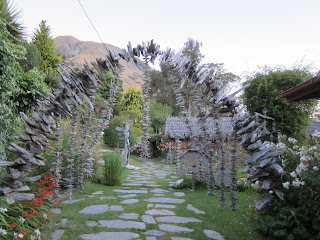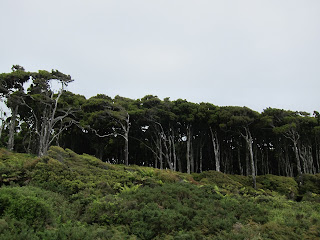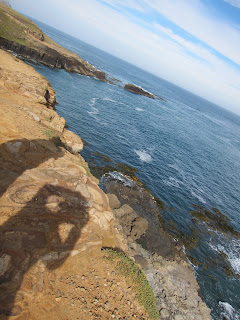So far, our posts about NZ have focused on the outdoors. Here is a taste of the human-made side of the South Island... since the latter helped us appreciate the former.
For example:
This is the view from our house in the Catlins, above the town of Papatowai. That's the sea in the distance.
We'll start with the less weird and move to the more weird...
We'll start with the less weird and move to the more weird...
Roads
We spent a fair amount of time on the road. Other than the occasional sheep-related interruption (see previous post), it was smooth sailing/driving.
Here are three places where the road became 'extreme' in one way or another:
1. We zoomed past this bridge, only just catching a picture of it:
What's special about that bridge is that it's where, according to our book, bungee-jumping was invented. Neither of us had any particular urge to give it a go.
2. The drive into Milford Sound wanders through valleys, and they suddenly plunges through a solid wall of granite. The one-way tunnel runs for just over a kilometer. Pretty impressive:
3. The city of Dunedin features the steepest street in the world (complete with black cat):
Buildings
Many of the buildings we saw were like buildings elsewhere, but a few stood out.
A museum in the cute coastal town called Hokitika:
The city of Queenstown is built along a lake, with buildings overlooking a sort of beach:
The (comparative) metropolis of Dunedin felt like an older European city:
It includes what is (supposedly) the most photographed railway station in the country:
And the interior:
On the shores of Lake Tekapo is a much-photographed chapel - it is, unsurprisingly, a popular spot for weddings.
Steampunk playground (?)
On our way up the east coast, we stopped in the town of Oamaru... which happens to be a center for steampunk fans. Here is the headquarters:
And here are two items from the local playground:
Weird.
For our third night, Naomi found us a place called 'Little Paradise Lodge.' It lived up to its name.
Here's the view of the approach:
And the sign at the entrance:
The garden is filled with various sculptures:
The house itself is filled from floor to ceiling with creativity.
Much of the floor was tiled with wedges of wood:
Much of the furniture was carved as well:
This was our room, called 'The Swan Room':
Perhaps the most amazing room was the bathroom, with stone-tiled walls with wood inlay, moss around the tub...
...and a nicely-placed fishtank over the toilet:
The communal kitchen had the best view of any place Colin has ever done dishes:
Lost Gypsy
The most exciting unhinged creativity we saw was in the town of Papatowai (where our first photo was from). We'd been told that we had to visit the Lost Gypsy Gallery - a collection of creations by a guy named Blair Somerville with a knack for bizarre automata.
Here's the campervan that contains his workshop:
The entrance to the outside gallery:
A lovely sitting area (look closely at the details):
Here is one of Blair's creations. One adds some water to the pot and the whole thing begins to move:
Inside the gallery was a 'piano', with the keys connected to everything from electric shavers to bells to a head with beads that shook:
Here's a so-so video (not ours) that will give you some idea.
And here's us gazing at one of Blair's more other-worldly creations...

























































